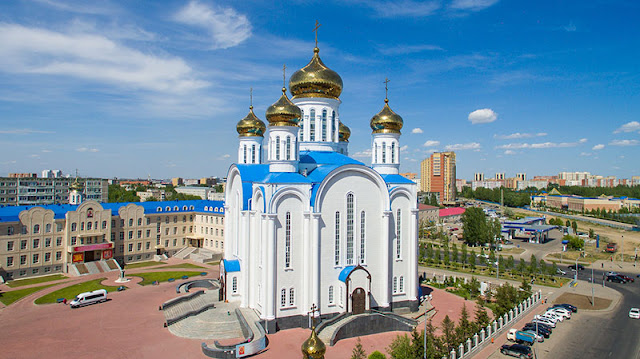Rising from Central Asia’s remote, open steppes, Astana has been hailed as the fastest growing capital in the world for many years. Known for its space-age skyscrapers and monuments dominating the skyline, the glittering capital of Kazakhstan is still devoid of hordes of tourists, which will not be the case in future.
Here are 4 Reasons why you should put Astana to the top of your bucket list.
Climate-sensitive Futuristic Buildings
 Khan Shatyr Entertainment Center / image credit
Khan Shatyr Entertainment Center / image creditWith extremes of the climate, Astana brims with futuristic buildings, several of which are designed by the renowned British architect Norman Foster. One of his masterpieces is Khan Shatyr Entertainment Centre, a transparent and towering tent-shaped steel structure soaring 150 meters into the Astana skyline. Inside the structure you can find a beach resort featuring swathes of sands imported from Maldives. Khan Shatyr’s quilted fabric roof provides relief from Astana’s extreme climates -- temperature can drop to minus 40 C in winter and reach up to 35 C in the summer.
 Bayterek tower / image credit
Bayterek tower / image creditThe 100-meter-tall Bayterek tower is another architectural wonder that has become synonymous with Kazakhstan’s capital. You can have a glimpse of the tower from almost every part in Astana.
The 77-metre-high pyramid-shaped Palace of Peace and Reconciliation is another famous building created by Foster. Built to host the Congress of Leaders of World, the monument serves as the centre for various religious groups in the country. The building houses opera house that can hold 1,500 people, art gallery and several conference facilities.
 Assumption Cathedral in Astana / Image credit
Assumption Cathedral in Astana / Image creditThe massive Russian Orthodox Assumption Cathedral, consecrated in 2010, can house up to 4,000 people.
 Hazrat Sultan Mosque / Image credit
Hazrat Sultan Mosque / Image creditWith its soaring white turrets, the Hazrat Sultan Mosque, the largest mosque in the country, is visited by some 10,000 worshippers.
 National Museum of the Republic of Kazakhstan / Image credit
National Museum of the Republic of Kazakhstan / Image creditAnother attraction that will detain the visitors to Astana is the blue-and-white marble National Museum of the Republic of Kazakhstan. The museum's Golden Hall is home to thousands of artefacts belonging to the Bronze Age.
Try Traditional Bathhouse Experience in Steamy saunas
One of the reasons why you must visit Astana is to enjoy a traditional bath in one of city’s several banya bathhouses. That Astana is the world's second-coldest capital after Mongolian capital of Ulan Bator is the reason that you should include this activity in the list of your best things to do in Astana.
Versatile dining
For sampling traditional Kazakh cuisines, Astana teems with large number of restaurants and eateries where you can try the quintessential Kazakh dish beshbarmak -- a noodle and meat combination with noodles and onion sauce. Another popular speciality is shashlyk, which is skewered meat.
Stunning nightlife
You can party the night away in the countless clubs in Astana. Chocolate Room in Radisson Hotel, Icon Club, in the heart of the city, The Barley, Zoloto and Hungry Rabbit are some of the avenues where you can immerse yourself in the stunning nightlife.
You will be richly rewarded by visiting the untapped city of Astana which is also a convenient base to explore the rest of the country.





No comments:
Post a Comment